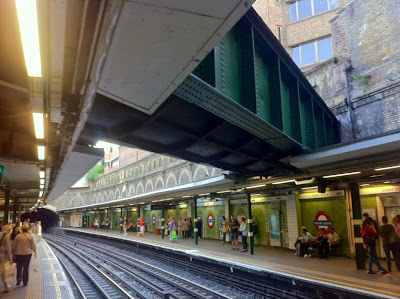This is Sloane Square tube station and there is something extraordinary about it: it has been built under a river.
There are many rivers in London. As well as the majestic Thames there are lesser known tributaries which continue to flow into it, such as the Lee in the north east, which was used as a moat around the Olympic Stadium. The Wandle, meanwhile, flows from the southern suburbs near Croydon, passing Lady Hamilton's house in Merton Place and Lord Nelson used to fish there.
Some have been buried, leaving traces in places above, like the Fleet, after which was named many streets, one of which became famous for the nearby newspapers. It has a Nelson angle too, for he used to stay with his uncle in Kentish Town "in order to keep an eye on the Fleet".
The Westbourne is less well know but at least it remains on display, if clothed in the metal pipe above. In size it is similar to the Fleet and arose from the hills around Hampstead, flowing down through what is now Hyde Park down to Chelsea where it meets the Thames.
The part through Hyde Park was damned in a curving lake, hence its name of the Serpentine, where it is used for boating to this day, though the water no longer comes from the Westbourne. So it too has an Olympic link, for it was here that they held the triathlons in 2012.
But as London grew it became increasingly polluted, first an open sewer, then covered over, built upon, it's end, where it joins the Thames, renamed as Ranelagh Sewer.
No longer do cattle drink from its fresh waters, nor do travellers heading into London from the west need to bridges to keep their feet dry.
But, visible to anyone standing on the platforms of Sloane Square Station, the Westbourne is not forgotten, particularly on this day, which is World Rivers Day 2013.

2 comments:
Wow, I need to look up more.
I have one of the books about the Lost Rivers of London and very interesting it is too. London is full of weird and wonderful history and stories - see some of Peter Ackroyd's books.
Post a Comment